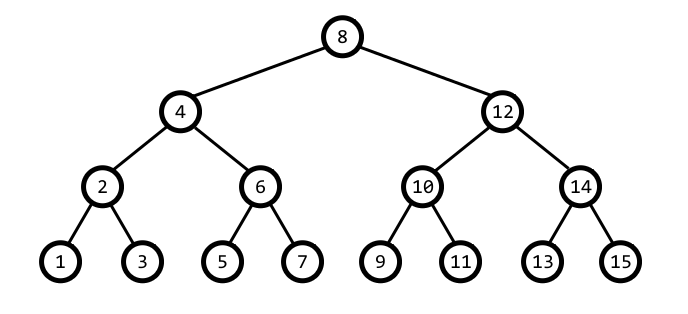Paths in a Complete Binary Tree
题意翻译
给定一棵拥有 $n$ 个节点的满二叉树,第 $i$ 个节点的编号为**对这棵满二叉树做中序遍历的时间戳**。
每次询问给定一个数 $x$ 与一个字符串。字符串中的第 $i$ 位若为 $U$,表示 $x$ 要变成 $x$ 的父节点的编号;若为 $L$,则表示 $x$ 要变成其**左**孩子的编号;若为 $R$,表示 $x$ 要变成其**右**孩子的编号。如果某个字符不合法(比如当前 $x$ 为一个叶节点的编号,而这个字符却是 $L$ 或 $R$ ),就跳过这个操作。
求经过所有操作后,$x$ 的值是多少。
题目描述
$ T $ is a complete binary tree consisting of $ n $ vertices. It means that exactly one vertex is a root, and each vertex is either a leaf (and doesn't have children) or an inner node (and has exactly two children). All leaves of a complete binary tree have the same depth (distance from the root). So $ n $ is a number such that $ n+1 $ is a power of $ 2 $ .
In the picture you can see a complete binary tree with $ n=15 $ .
Vertices are numbered from $ 1 $ to $ n $ in a special recursive way: we recursively assign numbers to all vertices from the left subtree (if current vertex is not a leaf), then assign a number to the current vertex, and then recursively assign numbers to all vertices from the right subtree (if it exists). In the picture vertices are numbered exactly using this algorithm. It is clear that for each size of a complete binary tree exists exactly one way to give numbers to all vertices. This way of numbering is called symmetric.
You have to write a program that for given $ n $ answers $ q $ queries to the tree.
Each query consists of an integer number $ u_{i} $ ( $ 1<=u_{i}<=n $ ) and a string $ s_{i} $ , where $ u_{i} $ is the number of vertex, and $ s_{i} $ represents the path starting from this vertex. String $ s_{i} $ doesn't contain any characters other than 'L', 'R' and 'U', which mean traverse to the left child, to the right child and to the parent, respectively. Characters from $ s_{i} $ have to be processed from left to right, considering that $ u_{i} $ is the vertex where the path starts. If it's impossible to process a character (for example, to go to the left child of a leaf), then you have to skip it. The answer is the number of vertex where the path represented by $ s_{i} $ ends.
For example, if $ u_{i}=4 $ and $ s_{i}= $ «UURL», then the answer is $ 10 $ .
输入输出格式
输入格式
The first line contains two integer numbers $ n $ and $ q $ ( $ 1<=n<=10^{18} $ , $ q>=1 $ ). $ n $ is such that $ n+1 $ is a power of $ 2 $ .
The next $ 2q $ lines represent queries; each query consists of two consecutive lines. The first of these two lines contains $ u_{i} $ ( $ 1<=u_{i}<=n $ ), the second contains non-empty string $ s_{i} $ . $ s_{i} $ doesn't contain any characters other than 'L', 'R' and 'U'.
It is guaranteed that the sum of lengths of $ s_{i} $ (for each $ i $ such that $ 1<=i<=q $ ) doesn't exceed $ 10^{5} $ .
输出格式
Print $ q $ numbers, $ i $ -th number must be the answer to the $ i $ -th query.
输入输出样例
输入样例 #1
15 2
4
UURL
8
LRLLLLLLLL
输出样例 #1
10
5